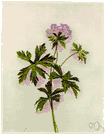wild geranium
n.
An eastern North American woodland geranium (Geranium maculatum) having rose-purple flowers. Also called spotted geranium.
American Heritage® Dictionary of the English Language, Fifth Edition. Copyright © 2016 by Houghton Mifflin Harcourt Publishing Company. Published by Houghton Mifflin Harcourt Publishing Company. All rights reserved.
wild′ gera′nium
n.
a geranium, Geranium maculatum, of E North America, having loose clusters of lavender flowers.
[1880–85]
Random House Kernerman Webster's College Dictionary, © 2010 K Dictionaries Ltd. Copyright 2005, 1997, 1991 by Random House, Inc. All rights reserved.
ThesaurusAntonymsRelated WordsSynonymsLegend:
| Noun | 1. |  wild geranium - common wild geranium of eastern North America with deeply parted leaves and rose-purple flowers wild geranium - common wild geranium of eastern North America with deeply parted leaves and rose-purple flowerscrane's bill, cranesbill - any of numerous geraniums of the genus Geranium |
Based on WordNet 3.0, Farlex clipart collection. © 2003-2012 Princeton University, Farlex Inc.